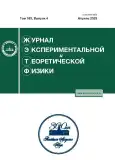Nonlinear Parametric Resonance in the Simplest Model of a Solar Dynamo
- Autores: Serenkova A.Y.1, Sokolov D.D2, Yushkov E.V1,3,4
-
Afiliações:
- Physics Faculty, Lomonosov Moscow State University
- Physics Faculty, Lomonosov Moscow State Universityж Moscow Center of Fundamental and Applied Mathematics
- Moscow Center of Fundamental and Applied Mathematics
- Space Research Institute
- Edição: Volume 163, Nº 4 (2023)
- Páginas: 514-523
- Seção: Articles
- URL: https://journals.rcsi.science/0044-4510/article/view/145389
- DOI: https://doi.org/10.31857/S0044451023040089
- EDN: https://elibrary.ru/LUGKNR
- ID: 145389
Citar
Texto integral
Resumo
The properties of nonlinear parametric resonance are investigated using the example of the low-mode Parker dynamo model. This model is a system of four ordinary differential equations and in the simplest approximation describes the processes of generation and oscillation of large-scale magnetic fields in stellar systems. In the absence of nonlinear effects, the problem under consideration, by analogy with a system of harmonic oscillations, admits an asymptotic division of multiple resonant frequencies. However, despite the fact that at first glance at these frequencies it is reasonable to expect an amplification of the amplitude in the nonlinear case, it is demonstrated that in the presence of nonlinear terms, the behavior of the system is significantly more complex. In particular, generation suppression can be observed at resonant or low frequencies, while amplification occurs in the immediate vicinity of the resonance or at sufficiently high frequencies. The reasons are discussed for this behavior, as well as the possibility of the influence of parametric resonance on the establishment of planetary dynamo cycles.
Sobre autores
A. Serenkova
Physics Faculty, Lomonosov Moscow State University
Email: serenkova.ai19@physics.msu.ru
119991, Moscow, Russia
D. Sokolov
Physics Faculty, Lomonosov Moscow State Universityж Moscow Center of Fundamental and Applied Mathematics
Email: serenkova.ai19@physics.msu.ru
119991, Moscow, Russia; 119991, Moscow, Russia
E. Yushkov
Physics Faculty, Lomonosov Moscow State University; Moscow Center of Fundamental and Applied Mathematics; Space Research Institute
Autor responsável pela correspondência
Email: yushkov.msu@mail.ru
119991, Moscow, Russia; 119991, Moscow, Russia; 117997, Moscow, Russia
Bibliografia
- V.N. Obridko, M.M. Katsova, and D.D. Sokolo, Monthly Notices of the Royal Astronomical Society 516.1, 1251 (2022).
- F. Stefani, J. Beer, A. Giesecke, T. Gloaguen, M. Seilmayer, R. Stepanov, and T. Weier, Astronomische Nachrichten 341, 600 (2020).
- D. Moss and D. Sokoloff, Astr. and Astrophys. 553, A37 (2013).
- D. Moss and D. Sokoloff, Astr. Reps. 61(10), 878 (2017).
- D. Moss, N. Piskunov, and D. Sokolo, Astr. and Astrophys. 396(3), 885 (2002).
- E.N. Parker, The Astrophys. J. 122, 293 (1955).
- N.W. McLachlan, Theory and Application of Mathieu Functions, Clarendon Press, Oxford (1947).
- Ф. Краузе, К.-Х. Рэдлер, Магнитная гидродинамика средних полей и теория динамо, Пер. с англ., Мир, Москва (1984).
- Л. Ландау, Е. Лифшиц, Теоретическая физика, Физматлит, Москва (2001).
- H. Schwabe, S onnenbeobachtungen im Jahre 1843, Von Herrn Hofrath Schwabe in Dessau. 21, 233 (1844).
- M.N. Gnevyshev, Solar Phys. 51(1), 175 (1977).
- S.M. Tarbeeva, V.B. Semikoz, and D.D. Sokolo, Astr. Reps. 55(5), 456 (2011).
- G.Ruediger and A. Brandenburg, Astr. and Astrophys. 296, 557 (1995).
- J.C. Butcher, Numerical Methods for Ordinary Di erential Equations, John Wiley and Sons (2016).
- S.M. Stigler, The History of Statistics: The Measurement of Uncertainty Before 1900, Harvard University Press, Harvard (1986).
- Л.Л. Кичатинов, А.А. Непомнящих, Письма в Астрон. Ж. 41(7), 409 (2015).
Arquivos suplementares









